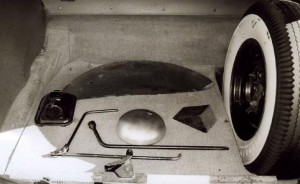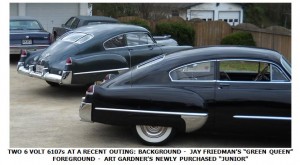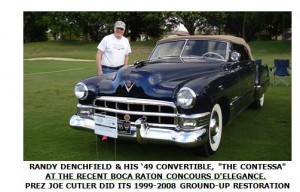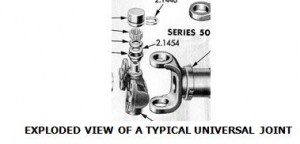If you bought your new ’49 without many options and decided later that you just had to have one or more of these goodies, all was not lost. On December 2, 1948, in the “Parts and Accessories Bulletin” below, the Cadillac factory informed distributors and dealers that many of these were available for sale. The “net” price in the bulletin is what the dealer paid for the item, while the car owner paid the “list” price.
CADILLAC MOTOR CAR DIVISION
GENERAL MOTORS CORPORATION
DETROIT 32, MICHIGAN
PARTS AND ACCESSORIES BULLETIN, No. 494, December 2, 1948
TO ALL DISTRIBUTORS AND DEALERS:
Subject: 1949 Accessories Prices
Accessory Name Part # Net List Installation
Radio, Front Compartment 49-60S,61 ,62,75
7258155
62.80
81.00
4.50
Antenna; Fender Mtg. 49-60s,61,62
1455342
8.65
12.00
1.60
Antenna, Fender Mtg. 49-75
1455343
8.65
12.00
1.60
Radio, Rear Compartment 49-75
7241938
93.50
115.00
Installation Kit, Rear Radio (Without E1ec. Div. Lift)
1453217
16.50
20.00
Installation Kit, Rear Radio (With E1ec. Div. Lift)
1453218
16.50
20.00
Radio & Kit, Rear Compt. 49-75
—
110.00
135.00
12.00
Antenna, Trunk Mtg. 49-75
1444172
10.00
13.50
3.50
Auxiliary Radio Speaker
7258495
12.35
18.85
6.00
Automatic Heating System 49-605.61,62
3122353
79.00
98.50
8.50
Automatic Heating System 49-75
3122354
110.00
132.00
8.50
Standard Heating System 49-60s,61.62
3122931
40.00
50.00
5.00
Fog Lamps (Pair) 49-605,61,62
929089
32.00
40.00
0
Fog Lamps (Pair) 49-75
929122
32.00
40.00
0
Back-Up Lights (Dual) 49-60S, 61, 62
929151
11.50
15.00
3.50
Back-Up Lights (Single) 49-75
929150
7.20
9.50
2.50
Spotlight with Mirror (Left) 49-60S, 61, 62
929117
18.25
25.95
3.25
Spotlight with Mirror (Right) 49-60S, 61, 62
929106
18.25
25.95
3.25
Glareproof Mirror
145416
5.20
6.50
0
Outside Rear View Mirror 1454905-6 3.85 6.00 0.50
Special Steering Wheel 3630079 18.00 22.50 0
Sun Visor 1455598-99 7.50 12.50 2.50
Chrome Wheel Disc (Sombrero Hub Cap) 3508244-821 6.80 8.00 0
Chrome Trim Ring (With Small Hub Cap) 1097728 1.52 1.90 0
Windshield Washer 1455132 5.75 8.25 2.75
There seems to be a 35% mark-up between the two prices. Of even more interest is the relative difference between what these items cost when our cars were new and what you might pay for them today, either NOS or second-hand. For example, a front compartment radio listed for $81 in December 1948, while its vacuum antenna cost only $12. A working ’49 Cadillac radio usually can be bought today for between $50 and $200 depending on your luck or bargaining skills, but a vacuum antenna with a good mast and which works well is at least that much, if not hundreds of dollars more. Also, while a non-working radio can probably be repaired for no more than a couple of hundred bucks, to have your antenna restored is equally expensive.
Similarly, a windshield washer set up is $8.25 on the list. While a windshield washer pump is inexpensive today, an authentic square bottle is hard to find and can cost hundreds of dollars.
Another item of interest is the Automatic Heating System, which lists for $132 on a Series 75 limo and $98.50 on lesser cars. Installation of either was only $8.50 back then, but it is very telling that this is the second most expensive installation job on the list; the first being the $12 cost of installing the rear radio on a Series 75. Though I’ve never worked on a Series 75 rear radio, as anyone who has worked on the complicated Automatic Heating System can tell you, 8½ bucks to install it is probably the biggest bargain on the list.
Another item that seems relatively expensive is the Auxiliary Radio Speaker which mounts on the rear package shelf. At $18.85 it cost more than a vacuum antenna back then, yet today these can be purchased relatively cheaply; for example, I bought one for $10 several years ago. However, the installation of a rear speaker is the third most expensive installation job on the list at $6. This is understandable, since it is time consuming to cut a hole for the speaker in the rear package shelf, then run a wire from its dash switch up inside the windshield post and then between the headliner and the roof of the car into the trunk area, somehow without harming the headliner.
The same is true of back up lights, a pair of which for Series 60, 61 and 62 listed for $11.50, also more than an antenna. Yet today a pair of back up lights are not expensive to buy. At $3.50 their installation in 1948 cost less than installing a speaker, since their wire simply runs out in the open from the coil, then down the firewall to a fuse, then under the car to the transmission switch and back to the trunk.
An item that seems about right in relative terms is sombrero hub caps. At 8 bucks each, a set of them would set you back $32, which was lots of money back then. A set of new sombreros today costs hundreds of dollars, making it about the same cost in terms of 2011 dollars.
Conspicuous by their absence on this Dec. ’48 list are fuel filters and oil filters. However, later in the model year they were both offered as a dealer option. As an option, , the list price of the fuel filter was $3.20, but from about VIN number 49xx33500, which would be cars built in May 1949 and later, fuel filters became standard factory equipment. Oil filters, on the other hand, only became standard factory equipment in 1954, though research by ‘49er Fred Hammerle has shown that a few ’49 Cads did have factory installed oil filters.
newsletter




